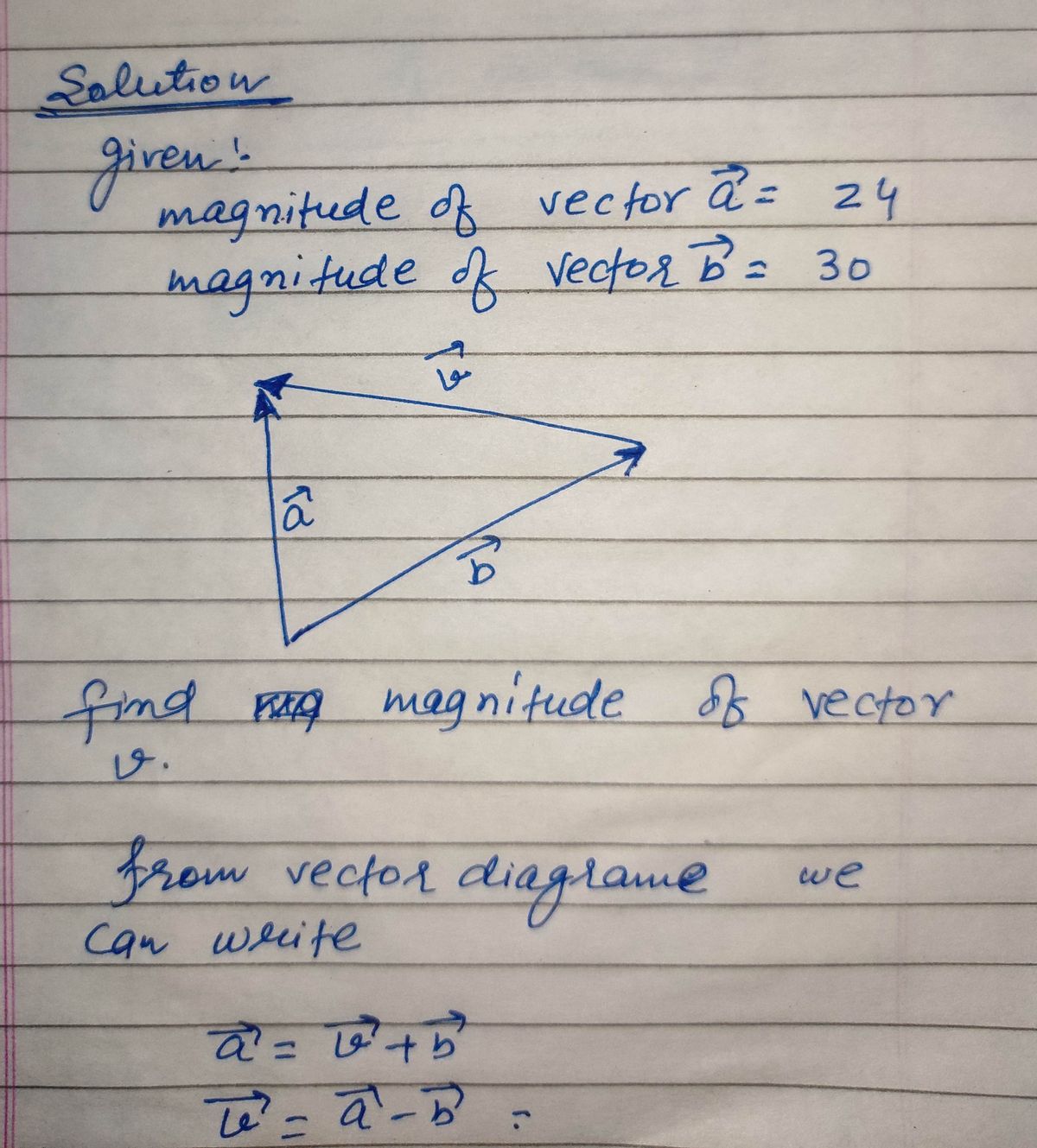Below is given information for the vectors shown in the diagram: The direction of vector a is a = 60° with a magnitude of 24. %3D The direction of vector b is B = 35° with a magnitude of 30. %3D à Find the magnitude of vector v to one decimal place. 36.7 1-0
Below is given information for the vectors shown in the diagram: The direction of vector a is a = 60° with a magnitude of 24. %3D The direction of vector b is B = 35° with a magnitude of 30. %3D à Find the magnitude of vector v to one decimal place. 36.7 1-0
Trigonometry (11th Edition)
11th Edition
ISBN:9780134217437
Author:Margaret L. Lial, John Hornsby, David I. Schneider, Callie Daniels
Publisher:Margaret L. Lial, John Hornsby, David I. Schneider, Callie Daniels
Chapter1: Trigonometric Functions
Section: Chapter Questions
Problem 1RE:
1. Give the measures of the complement and the supplement of an angle measuring 35°.
Related questions
Question
![Below is given information for the vectors shown in the diagram:
The **direction** of vector **a** is \(\alpha = 60^\circ\) with a **magnitude** of 24.
The **direction** of vector **b** is \(\beta = 35^\circ\) with a **magnitude** of 30.
[Diagram Description]
- The diagram features vectors \(\vec{a}\), \(\vec{b}\), and \(\vec{v}\).
- Vector \(\vec{a}\) is represented as a blue line, originating from a common point and following an angle \(\alpha\) of \(60^\circ\).
- Vector \(\vec{b}\) is depicted as a red line, originating from the same point with an angle \(\beta\) of \(35^\circ\).
- The two vectors form an angle at their intersection point.
- Vector \(\vec{v}\) is shown as a black line, representing the resultant vector.
To solve:
Find the **magnitude** of vector \(\vec{v}\) to one decimal place.
Solution box: \(36.7\)](/v2/_next/image?url=https%3A%2F%2Fcontent.bartleby.com%2Fqna-images%2Fquestion%2F322ab9b5-8b73-42ca-a79a-5c7ee3611144%2Fffbb3572-c9f2-44b1-8dbd-92064ded6131%2F1avhdye_processed.jpeg&w=3840&q=75)
Transcribed Image Text:Below is given information for the vectors shown in the diagram:
The **direction** of vector **a** is \(\alpha = 60^\circ\) with a **magnitude** of 24.
The **direction** of vector **b** is \(\beta = 35^\circ\) with a **magnitude** of 30.
[Diagram Description]
- The diagram features vectors \(\vec{a}\), \(\vec{b}\), and \(\vec{v}\).
- Vector \(\vec{a}\) is represented as a blue line, originating from a common point and following an angle \(\alpha\) of \(60^\circ\).
- Vector \(\vec{b}\) is depicted as a red line, originating from the same point with an angle \(\beta\) of \(35^\circ\).
- The two vectors form an angle at their intersection point.
- Vector \(\vec{v}\) is shown as a black line, representing the resultant vector.
To solve:
Find the **magnitude** of vector \(\vec{v}\) to one decimal place.
Solution box: \(36.7\)
Expert Solution
Step 1

Step by step
Solved in 2 steps with 2 images

Recommended textbooks for you

Trigonometry (11th Edition)
Trigonometry
ISBN:
9780134217437
Author:
Margaret L. Lial, John Hornsby, David I. Schneider, Callie Daniels
Publisher:
PEARSON

Trigonometry (MindTap Course List)
Trigonometry
ISBN:
9781305652224
Author:
Charles P. McKeague, Mark D. Turner
Publisher:
Cengage Learning


Trigonometry (11th Edition)
Trigonometry
ISBN:
9780134217437
Author:
Margaret L. Lial, John Hornsby, David I. Schneider, Callie Daniels
Publisher:
PEARSON

Trigonometry (MindTap Course List)
Trigonometry
ISBN:
9781305652224
Author:
Charles P. McKeague, Mark D. Turner
Publisher:
Cengage Learning


Trigonometry (MindTap Course List)
Trigonometry
ISBN:
9781337278461
Author:
Ron Larson
Publisher:
Cengage Learning